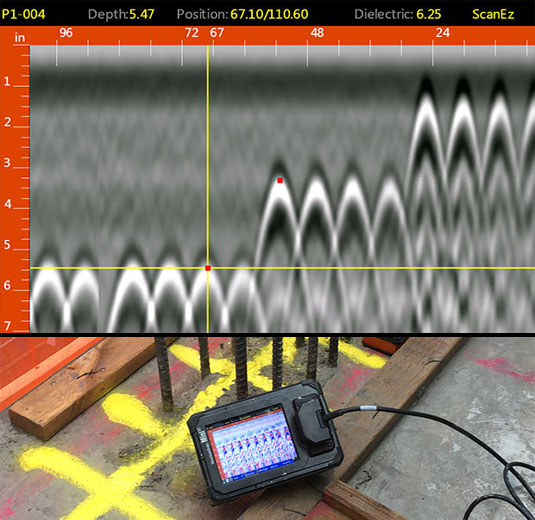Advanced Concrete Scanning Techniques: Making Sure Structural Honesty
Advanced Concrete Scanning Techniques: Making Sure Structural Honesty
Blog Article
Past the Surface Area: Leveraging Advanced Concrete Scanning Techniques for Unmatched Accuracy and Insight
Advanced concrete scanning methods have emerged as crucial tools in this quest, using a glance underneath the surface area to unveil a globe of essential insights. By taking advantage of cutting-edge modern technologies, specialists can reveal anomalies, examine the problem of concrete frameworks, and make informed choices that form the course of jobs.
Significance of Advanced Concrete Scanning
The significance of making use of sophisticated concrete scanning techniques hinges on the unmatched precision they use for discovering sub-surface anomalies and making sure structural honesty. By employing cutting-edge technologies such as ground-penetrating radar (GPR), electromagnetic induction, and progressed finder imaging, building and construction specialists can dive beneath the surface of concrete structures with a degree of accuracy that far exceeds standard assessment approaches. Concrete Scanning. These methods make it possible for the identification of covert risks like rebar deterioration, spaces, conduits, or post-tension cables that can compromise the stability and safety and security of a structure in time
Moreover, progressed concrete scanning provides indispensable understandings right into the total problem of a concrete aspect without the need for invasive procedures, lessening the danger of causing damage throughout the assessment procedure. The capability to determine the precise place and depth of potential problems permits targeted fixings and upkeep, ultimately extending the life expectancy of the framework and enhancing its performance. Essentially, the significance of innovative concrete scanning can not be overstated in the world of building and facilities upkeep, where precision and reliability are critical.
Kinds Of Cutting-Edge Technologies

Abnormalities and Issue Detection

Along with GPR, concrete scanning methods like thermography and impact-echo screening are additionally effective in finding flaws and abnormalities. Thermography utilizes infrared modern technology to determine variants in surface temperature, indicating prospective areas of concern such as delamination or wetness access. On the various other hand, impact-echo testing includes analyzing acoustic actions to find spaces, fractures, and other problems within the concrete. By leveraging these sophisticated techniques, experts can proactively attend to architectural problems, guaranteeing the long life and security of concrete frameworks.
Assessing Concrete Condition
Exactly how can engineers properly evaluate the problem of concrete frameworks to ensure their long life and safety and security? Examining the concrete condition is a crucial element of keeping framework stability. Different advanced concrete scanning strategies are utilized for this objective. Ground-penetrating radar (GPR) is typically used to analyze the interior structure of concrete, identifying gaps, cracks, and other anomalies that might endanger its strength. In addition, impact-echo screening can supply insights into the thickness and integrity of concrete components. Ultrasonic pulse speed screening is an additional important technique for reviewing concrete quality by determining the speed of acoustic waves via the product.
Incorporating non-destructive testing approaches with visual evaluations permits for a comprehensive evaluation Visit Website of concrete problem, enabling designers to identify possible concerns early on and apply timely upkeep or repair services. By leveraging these sophisticated strategies, engineers can guarantee the lasting durability and security of concrete structures.
Enhancing Decision-Making Procedures
In the world of facilities monitoring, maximizing decision-making procedures is essential for guaranteeing the efficient maintenance and durability of concrete structures. Enhanced decision-making procedures in concrete monitoring involve using sophisticated scanning techniques to collect comprehensive information on the problem of structures. By leveraging technologies such as ground-penetrating radar and 3D imaging, stakeholders can make informed decisions relating to replacement, repair work, or support strategies.
These advanced scanning techniques provide important insights into the internal structure of concrete, recognizing possible concerns such as voids, fractures, or deterioration that might not show up externally. This level of detailed information permits for aggressive upkeep preparation, minimizing the danger of architectural failures and boosting the total lifespan of concrete frameworks.
Furthermore, by integrating electronic documents and evaluation tools right into the decision-making procedure, stakeholders can track the development of concrete conditions gradually, enabling predictive upkeep techniques and maximizing source allotment. Eventually, the assimilation of advanced concrete scanning techniques enhances decision-making processes by supplying unparalleled accuracy, understanding, and effectiveness in infrastructure administration.
Conclusion
Finally, progressed concrete scanning strategies offer unmatched precision and understanding in identifying abnormalities, problems, click this and examining the problem of concrete frameworks. By leveraging innovative innovations, decision-making procedures can be enhanced, resulting in even more educated and effective services for maintaining and fixing concrete infrastructure. These strategies play a vital function in ensuring the safety and security and long life of concrete structures, making them a vital tool in the area of construction and engineering.
Moreover, progressed concrete scanning supplies important understandings right into the total condition of a concrete element without the demand for intrusive procedures, minimizing the danger of causing damage during the assessment procedure - Concrete Scanning. An additional innovative modern technology is 3D X-ray scanning, which supplies comprehensive images of the inner structure of concrete, using useful information without the need for devastating why not check here screening. In Addition, Concrete Cover Meters are utilized to measure the density of concrete cover over reinforcement bars properly. Boosted decision-making processes in concrete administration entail making use of sophisticated scanning strategies to gather detailed data on the problem of structures.In final thought, advanced concrete scanning methods use unrivaled precision and insight in detecting abnormalities, defects, and examining the condition of concrete structures
Report this page